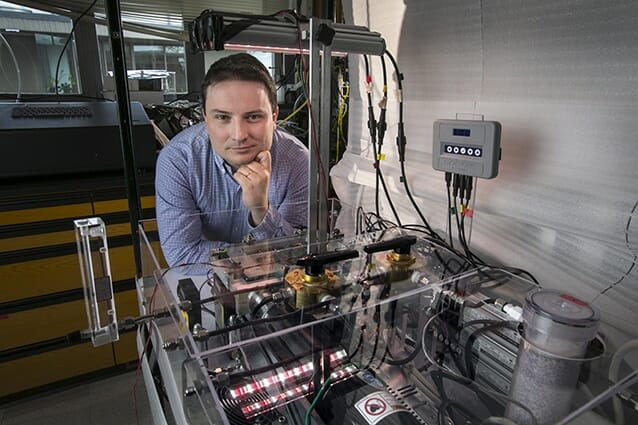
30 Mar Innovator Spotlight: Department of Geosciences at Princeton University
Predicting the Impact of Climate Change on Plant Ecosystems
W hile most everyone is familiar with the broad concept of climate change and its potential impact on the health and future of our planet, a razor-sharp researcher is toiling away in a lab in the Department of Geosciences at Princeton University to explore a little-understood but fundamentally critical aspect of the environmental crisis: the relationship between photosynthesis and respiration.

Dr. Paul Gauthier is an associate researcher in Princeton University’s Department of Geosciences, which is housed in Guyot Hall.
Dr. Paul P.G. Gauthier, born in France and educated globally, is seeking to understand how plants maintain a delicate balance between storing energy (photosynthesis) and releasing energy (respiration) as all species are affected by changes in light intensity, temperature and CO2 levels brought on by climate change.
It’s important work, given the intricate relationship between humans and plants. We depend on plants not only for food, but indeed our very existence is intrinsically tied to our green friends: They absorb the carbon dioxide we expel with each breath, and in exchange give us life-sustaining oxygen.

Plant respiration is measured in Gauthier’s lab.
Gauthier, an associate research scholar in plant physiology and metabolism, says that one of the most fascinating challenges mankind will face in the 21st century and beyond is the impact of climate change on the terrestrial biosphere.
According to Gauthier, “Plants are sensitive to their environment, and changes in water availability, temperature, light or nutrients can have dramatic consequences on long-term ecosystem sustainability. My work aims to understand and model the metabolic and physiological responses of plants and ecosystems to abiotic stresses induced by climate change.”

Gauthier studies the carbon balance within plants in the field and in his lab where he conducts extremely precise experiments under Fluence LED systems.
Gauthier studies the carbon balance within plants both in the field (well, literally in our forests) and in his lab where he conducts extremely precise experiments under specially designed Fluence LED systems that mimic daily variation in sunlight.
“We need extremely precise light intensity. We need to be able to increase or decrease light by as little as one micromole,” says Gauthier. “We also need very precise spectra in the visible light spectra (400 – 700 nm). Many LEDs are either too rich in red or too rich in blue when plants need both red and blue in the right balance.”
Fluence was able to provide a lighting system that has enabled a more precise research that could not be achieved otherwise,” Gauthier says.
Low heat emission is also critical to his studies, Gauthier says. “We need to make sure that the heat radiation reaching the leaf isn’t too great. Being able to control leaf temperature is challenging and limitation heat radiation is critical. With Fluence LED systems, we were able to overcome this barrier compared to conventional light sources.
In his experiments, Gauthier applies various light intensities to plant leaves to enhance photosynthesis and then analyze the gases coming in and out of the chamber where the leaf stands to assess its overall ability to uptake and release carbon.
Our system is able to make crucial measurements for understanding how plants respond to changes in light intensities,” says Gauthier.
Photosynthesis — the act of converting light and CO2 to life-sustaining sugars — and respiration — wherein sugars are burned to enable the plant to function — must be perfectly balanced to ensure plants’ survival.
“I’m trying to figure how climate change affects the balance of these two functions,” says Gauthier. If one or the other is too adversely affected by climate change, he says, plant survival is at risk.
“Respiration is what drives everything in plants. It helps control what plants take in. It’s why trees don’t get fat. Even if we maximize the resources necessary for plants to grow, they adapt and use the resources available but not too much. Plants, through respiration, know when they are full,” Gauthier explains.

Gauthier’s experiments analyze a leaf’s ability
to uptake and release carbon.
The natural balance between plants and our environment — which took billions of years to evolve to where we are today — is rapidly changing. The consequences are huge, yet the answers are being uncovered by studying something as small as the quantum of light. “It’s complicated, but it’s crucial to understand,” states Gauthier.
Our lives are at stake, he says. “When you have ecosystems that are threatened, there’s trouble,” he says. “Learning how a system changes and adapting (to those changes) now is critical.”
Fluence Bioengineering is proud to facilitate such important research.
Stay up to date on the latest research and findings out of Dr. Gauthier’s lab by visiting http://scholar.princeton.edu/ppg


